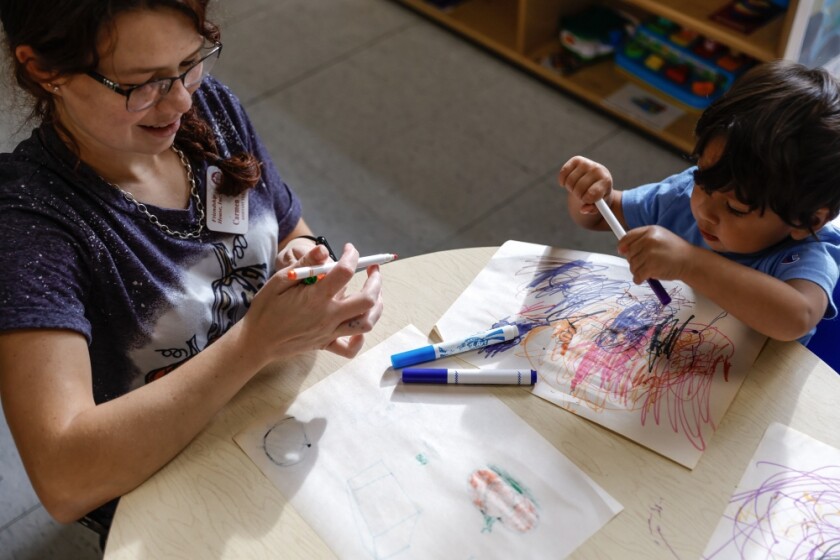The science of child development, particularly as it relates to brain development, has highlighted the importance of child care in setting the foundation for children’s lives. One key factor is the quality and consistency of adult-child interactions. The competency and stability of the child-care workforce is crucial to ensuring that children have the positive attachments they need.
The child-care workforce of nearly 2 million is one of the worst compensated in America. Nearly 15 percent of child-care staff live in families below the poverty line, and nearly 37 percent live in families below twice the poverty line. More than half of staff rely on at least one main public benefit program, such as Medicaid or SNAP, and only 15 percent get health insurance from their job.
Low compensation for child-care workers reflects the business of child care. It’s a labor-intensive industry; labor costs comprise about 70 percent to 80 percent of a typical program’s operating budget. These businesses operate on razor-thin margins, which means high costs for parents and low wages for staff. Not surprisingly, child-care programs across the country struggle to retain their workers.
The problem likely won't get better any time soon. Recovery from the pandemic has been slow for many child-care operators, in part because the tight employment market is siphoning away staff, who it seems can go literally anywhere for higher wages. But while pay is a major barrier to quality, boosting compensation alone will not solve the challenges facing our child-care workforce. The child-care business model is broken, and worse, overlooked.
That workforce lacks much of the foundational infrastructure needed to build a profession. There are no streamlined position definitions and aligned responsibilities and competencies, no career pathways, few accredited early childhood education programs and little public data on the workforce. Entry-level qualifications in most states are very low, and there are few clear ways for those working in the field to achieve higher levels of education and competence.
How should we address the problem? States — specifically, state child-care administrators — are key to advancing the child-care workforce. States have the authority to set requirements for the field and build infrastructure to sustain the sector.
To address the challenge of professionalizing the child-care workforce, states can follow two successful professional development models: Head Start and the Defense Department’s Child Care System. Both have pursued a “top down-bottom up” approach to building their workforces, aligning increased competency with higher compensation. By starting with where staff was, they built systems that began with the Child Development Associate Credential approach and moved up toward higher education levels. Both invested beyond the teaching role into leadership, coaching and support staff. Both had clear goals with a clear progression from one level to the next and included higher pay.
In a new report, the Bipartisan Policy Center outlines a state-level plan to create a competent and stable child-care workforce, comprising the following elements:
• State agencies should write or adopt definitions and competency expectations for the child-care workforce, including directors, teachers and support staff, and they should collect and connect all relevant data from child-care subsidies, program licensing, the Quality Rating and Improvement system, workforce registries, professional development, higher education and other germane programs.
• The agencies should determine the competency-based education and training required of each role and what resources individuals need to advance along a career path. They also should effectively communicate requirements and use a monitoring system to ensure that their workforce meets them.
• The agencies should determine the operating costs for a child-care center with a competent and stable workforce; determine the cost of education and training, compensation scales and workplace benefits, including health insurance and paid leave; and conduct a system-level cost model to determine the total cost of a child-care system that addresses gaps and meets short- and long-term goals.
• And the agencies should consider how to allocate available public funding to best meet their goals. That means deciding how and at what level they will boost child-care workforce wages and benefits through grants and contracts, stabilization funding such as the federal programs that were successful during the pandemic, and other mechanisms such as providing workers with pathways to credentials and degrees.
At the moment, there is no comprehensive approach in place to stabilize and support the child-care workforce. It’s long overdue that we create one.
Linda K. Smith is the director of the Early Childhood Development Initiative at the Bipartisan Policy Center. She most recently served as the deputy assistant secretary for early childhood development in the U.S. Department of Health and Human Services’ Administration for Children and Families.
Governing’s opinion columns reflect the views of their authors and not necessarily those of Governing’s editors or management.











